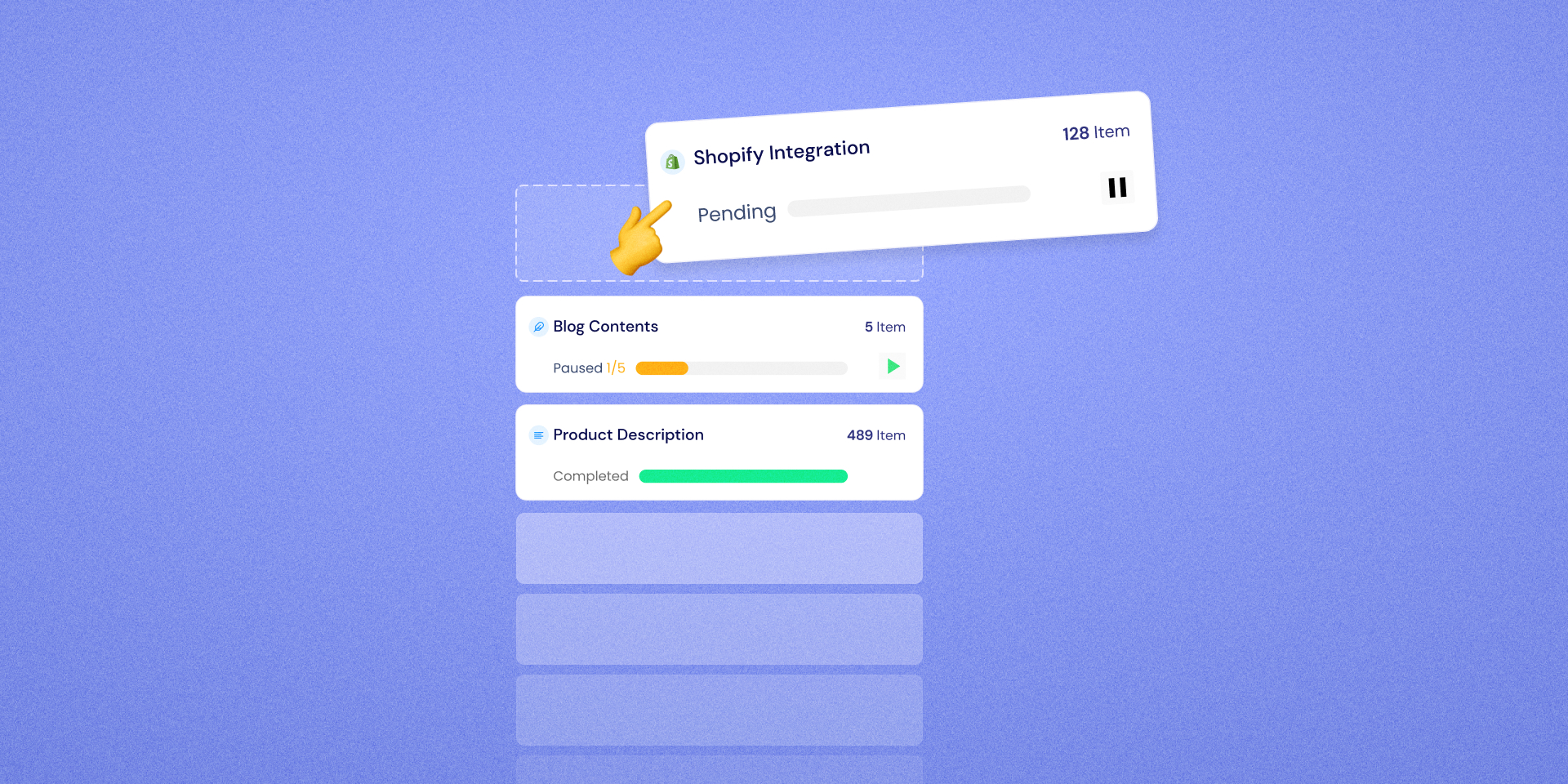If you are a content marketing or digital marketing expert, you will understand this: there is usually insufficient time to execute your content strategy’s ideal version. You plan it in your head and put it on the calendar, but creating the actual content part can become messy.
Producing high-quality, engaging content consistently is demanding and sometimes chaotic. It requires creativity, expertise, and time, which can be challenging to balance with other responsibilities.
If you are a social media manager or a content marketer who just realized this and ran to Google to ask: What is bulk content?
We get you!
While content marketing efforts need time and more effort, a fast-paced world demands our constant attention as marketers. From keeping up with the latest industry trends to responding to real-time events and audience feedback, the dynamic nature of digital marketing leaves little room for a relaxed approach.
This creates a perpetual cycle of juggling content creation, strategy refinement, and immediate marketing activities, especially if your company has many content pillars.
So what can you do? What is the solution?
This is where bulk content creation comes in. Creating content in bulk means planning and building your content weeks or months in advance. It allows you to produce significant material relatively quickly, helping you stay ahead of the curve and maintain a consistent online presence. You already know that consistency is crucial for building a loyal audience base.
It especially helps large companies manage their extensive editorial calendars more efficiently. With a well-planned schedule, your content can be published regularly and punctually, keeping your audience engaged and informed.
There are many other benefits to content creation, which we will explore below.
Without further ado, let’s move on to how to create bulk content.
How to Create Bulk Content

Generated with ContentGo AI
Ok. hold on, we will answer any questions regarding ‘’What is bulk content?’’ in this article.
You will learn every possible way you can create bulk content.
Bulk content creation involves a systematic and strategic approach to maximize efficiency and maintain quality. Whether you are producing content for social media, your blog, or other platforms, this process allows you to generate a substantial volume of material in a relatively short period of time. There are various methods for bulk content creation.
One effective method is to bulk-create specific elements used across multiple pieces of content. For instance, you can design a series of templates for your blog posts, social media updates, or email newsletters. These templates ensure consistency in branding and formatting, making the creation process faster and more consistent. Templates can include pre-defined layouts, fonts, color schemes, and placeholders for text and images, which you can quickly customize for each new piece of content.
Another approach is to focus on creating visual materials in bulk. This might involve taking a day to shoot a large batch of photographs, create a series of infographics, or record multiple videos. By dedicating concentrated time to producing visual assets, you can ensure a cohesive look and feel across your content while saving time on production.
But today, we will focus on creating bulk content for your blog. While creating parts of blog content in advance might not always be feasible due to the unique nature of each topic, there are still actionable steps to streamline the process and ensure a consistent output of high-quality posts. Let’s get into the steps:
1) SEO Research
SEO research is the foundation of your content strategy. You can scale this part, too. Use SEO tools to identify all the keywords and phrases your target audience is searching for. Covering the most important keywords allows you to create content ideas and plan them according to your strategy.
At ContentGo AI, we’ve streamlined this process. You can conduct SERP analysis and keyword research effortlessly and seamlessly incorporate those insights into your content briefs. You can see which questions are asked the most about your topic, the word counts of the top articles, image numbers, Text/HTML percentage, and the most commonly used words for the top 5 results. Add any detail to your brief that will help you catch up to your competitors.
Another feature is that you can create one brief for all the content you want to make while creating bulk content. So you can incorporate the insights into your bulk content briefs, too.
If you are curious about how it works, try it for yourself.
2) Planning and Scheduling
Planning is crucial when bulk-creating content. Begin by developing a comprehensive content calendar that details what content needs to be created, when it will be published, and which platforms it will appear on. This calendar should consider important dates, campaigns, and audience engagement patterns. By having a detailed content plan, you can identify which parts of your content can be created in bulk.
For instance, you can write a multi-part blog series together, design visual elements in advance, or conduct bulk research and create outlines beforehand. This method significantly reduces time and stress. You won’t need to worry about what to publish next, allowing you to focus on real-time adjustments to your strategies. This structured approach ensures a consistent flow of high-quality content while providing flexibility to respond to immediate opportunities and trends.
3) Creating Blog Outlines

Generated with ContentGo AI
After you research and plan, it is best to start creating blog outlines. Let’s say you want to make two months of blog content in advance. You have laid out your plan and found out your keywords. It’s time to structure each blog post to ensure a smooth writing process and high-quality output.
If you struggle with creating blog outlines, you can use ContentGo AI blog outline templates. Just enter your keywords, title, tone of voice, and how you want your content to be.
Curious? Check out now
When you create blog outlines in advance, you lay the groundwork for the writing process of all the content. Whether you plan to write it yourself or use a content generation tool, having detailed outlines ensures that each post is structured and aligned with your general content strategy. There will inevitably be parts that overlap, and you can continuously tweak and add to your outline before you start writing. This approach allows you to refine and improve your content before writing.
4) Creating Content And SEO Optimization
You can move on to content production once you have a plan and outline. Let’s say you will write about “AI-generated content” in two different blog posts in two months. To ensure efficiency and consistency, you can write these pieces of content in one sitting. You will probably research the same sites and find similar visuals anyway. If you focus on one content pillar or theme at a time, you can also maintain a consistent voice and flow.
While producing the content, make sure you are applying on-page SEO strategies. This includes optimizing your headlines, using target keywords naturally within the text, and incorporating meta descriptions that accurately reflect the content of your posts. Additionally, use internal linking to guide readers to other relevant content on your site and external linking to authoritative sources to back up your points.
5) Publishing
Once your content is polished and optimized, it’s time to publish and promote it. If you use any content management system (CMS), you can schedule the posts according to your content calendar. After publishing, promote your blog posts across various channels to maximize their reach. Share them on social media, include them in email newsletters, and consider using paid promotion to boost visibility.
Don’t forget to monitor the performance of your content using analytics tools like Google Analytics. Track key metrics such as page views, time on page, bounce rate, and social shares to evaluate the effectiveness of your posts. While creating your content in bulk, you will have more time to monitor your performance and adjust your strategies accordingly.
Why Choose Bulk Content Creation
Let’s face it: the demand for fresh, high-quality, and relevant content is constant. We must continually build our content libraries and drive organic traffic to our online hubs to stay competitive. However, marketing departments often lack the resources to meet this demand. Each piece of content should be crafted with precision to engage customers continually and create a community. Unfortunately, marketing departments usually juggle so many tasks that creating high-quality and creative content that your audience will like becomes harder each day.
You will undoubtedly fall behind if you don’t strategize and plan your content effectively. This is especially true for small and medium-sized companies, but even more so for larger companies like retail businesses.
For example, for big retailers, creating content must be highly streamlined due to the sheer volume of content pillars and topics they must cover. They have a vast array of subjects they want to be seen discussing, making a well-organized content strategy essential for maintaining visibility and engagement across all their platforms.
If you still ask yourself, “What is bulk content, and why should I create bulk content?” The shortest answer is that bulk content creation is a strategic approach offering numerous benefits, from increased efficiency and consistency to better resource allocation and planning. You can create content in bulk yourself, or you can use AI generator tools for this process.
Using AI generators for bulk content creation will save time and allow your team to focus on more strategic tasks. AI tools can produce high-quality content quickly, ensuring you maintain a consistent posting schedule without compromising quality.
What is Bulk Content and How ContentGo AI Helps
If you want to use an AI tool to create bulk content, ContentGo AI is a great option.
Here is how you can create bulk content with ContentGo AI:
Step 1: Signup or login to your ContentGo AI
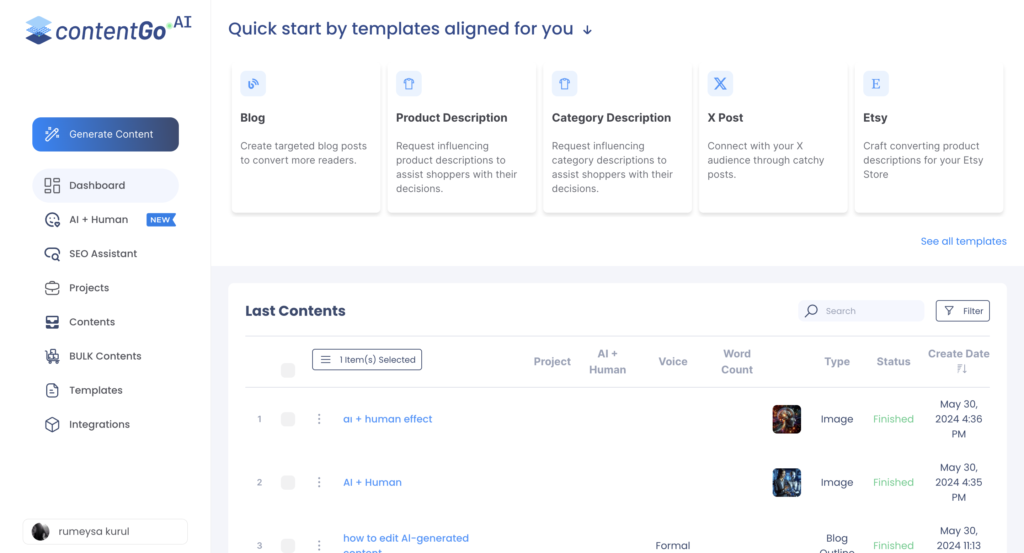
Step 2: Click on the Bulk Content option on the left menu
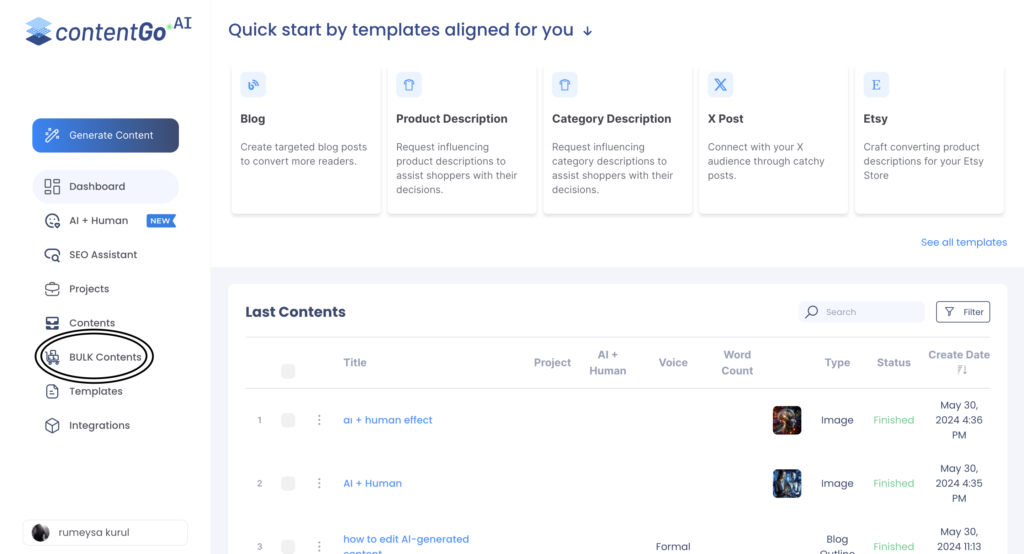
Step 3: Click ‘’Create’’ on the top right

Step 4: You can generate blog posts or product descriptions in bulk.
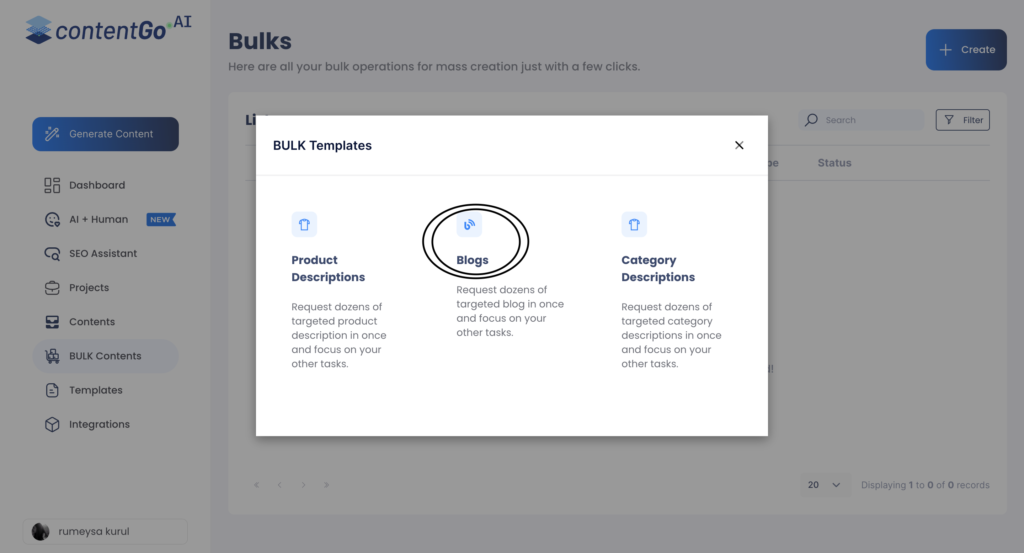
At this step, you can choose the one you want to proceed with.
Both options require the same inputs, so in this case, we will continue creating bulk content for blog posts.
Step 5: Fill in all your brief details.
It’s very important to enter the item count, the word count, and have the correct input and output languages.
SOS: Make sure that you have selected the ‘’Power Mode.’’
Once you fill in your details, click the ‘’Save’’ button.
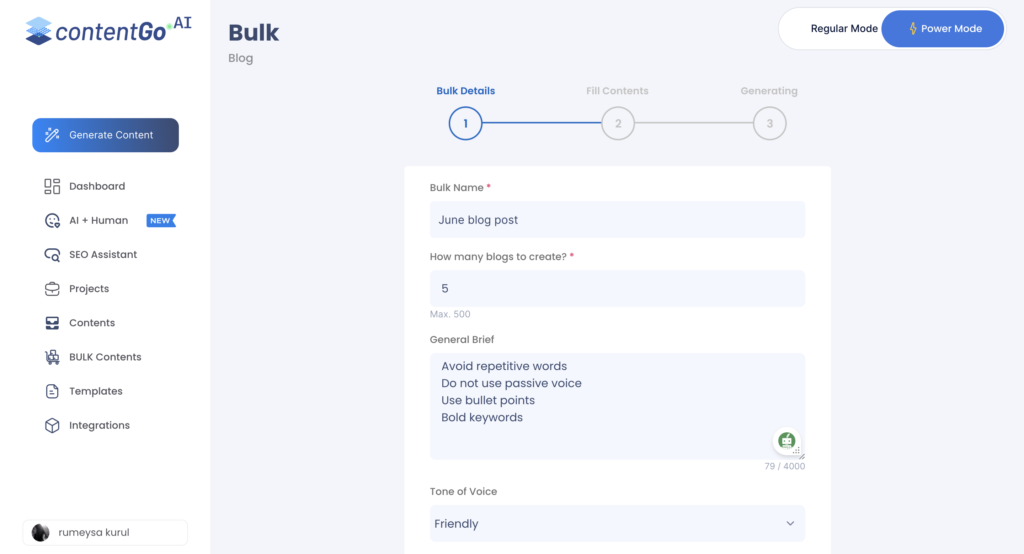
Step 6: In this step, enter your desired blog titles, keywords, and any content-specific notes you might have.
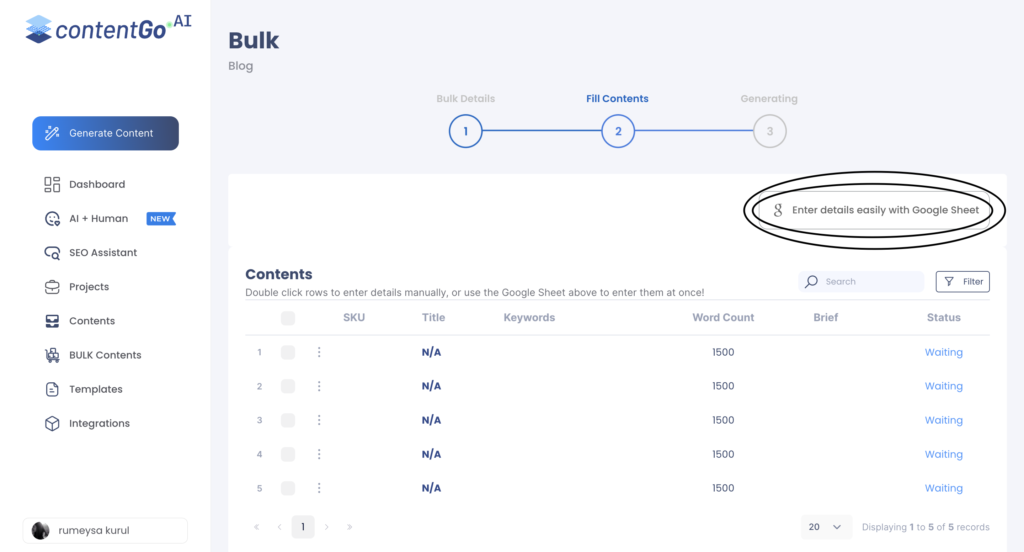

Step 7: Once done, click the ‘’Start the Bulk’’ button.

All the blog posts will start being generated instantly!

Remember, the generation time may vary based on the complexity of your content.
As the example shows, the average time for ten blog posts of 1000 words is 40 minutes!

You will be notified with an email once all the blog posts are generated.
Types of Bulk Content
You can create any content you want in bulk, but the ones listed below are usually strategically more effective and beneficial for SEO, maintaining consistency, and engaging your audience.
1) Blog Posts
Writing multiple blog posts at once lets you update your blog regularly, ensuring a steady flow of information for your readers. This can maintain your website’s SEO performance and keep your audience returning for more valuable insights.
2) Social Media Posts
Planning and creating batches of social media content in advance helps maintain an active presence across various platforms. This includes text updates, images, videos, infographics, and scheduled posts that can keep your audience engaged and informed about your brand. Plus, you will be able to post them automatically and be more active in engaging with your audience, real-time social listening, and other tasks you have on social media.
3) Videos
Whether it’s educational content, product demonstrations, tutorials, or interviews, having a library of video content ready ensures you can consistently deliver visual content that captures your audience’s attention. Think of it like creating branded stock footage. You can use these videos anywhere: as an event teaser, showreel, or your content.
4) Email Newsletters
Email newsletters come in handy when you prepare them beforehand. Typically, email marketing requires regular communication with your subscribers, and having a series of pre-written newsletters ensures you can maintain this consistency. By planning your content, you can tailor each newsletter to align with upcoming events, promotions, and key dates, keeping your audience engaged and informed about your latest updates. You can also bulk-create emails tailored to different segments of your audience.
5) Graphics and Visuals
If you create a library of graphics, illustrations, and photos that can be used across various content types, you will ensure that you have high-quality visuals ready to enhance your content. Here are some tips on how to create bulk images:
How to create bulk images
The first step is defining the type of images you need. These can be social media posts, blog graphics, product images, or infographics—whatever you have planned on your content calendar. You can use design tools like Canva or Photoshop to create consistent templates incorporating your brand colors, fonts, and logo.
Another way of creating bulk images is by scheduling photoshoots. To capture multiple images in one session, ensure you cover all necessary angles and subjects and take multiple variations to increase versatility. You can enhance your images using stock photo libraries and custom graphics to enhance your images.
The second step is to edit the images in bulk. You can use softwares like Adobe Lightroom or Photoshop, applying the same adjustments quickly with batch processing features and presets or filters for a consistent look.
You can also automate resizing and exporting tasks using tools like Canvas’s “Magic Resize” feature and organize your files with clear naming conventions in cloud storage solutions like Google Drive or Dropbox. By leveraging design automation tools and planning ahead, you can efficiently create high-quality images that maintain consistency across all your visual content.
If you want to scale up your content strategy and create a month’s worth of blog posts, ContentGo AI is a tool that will help you create high-quality content fast.
Just follow the steps mentioned above, and you can create months or 3 months worth of content, whatever you like.
Sign up today, and enjoy being ahead of your content plan.
